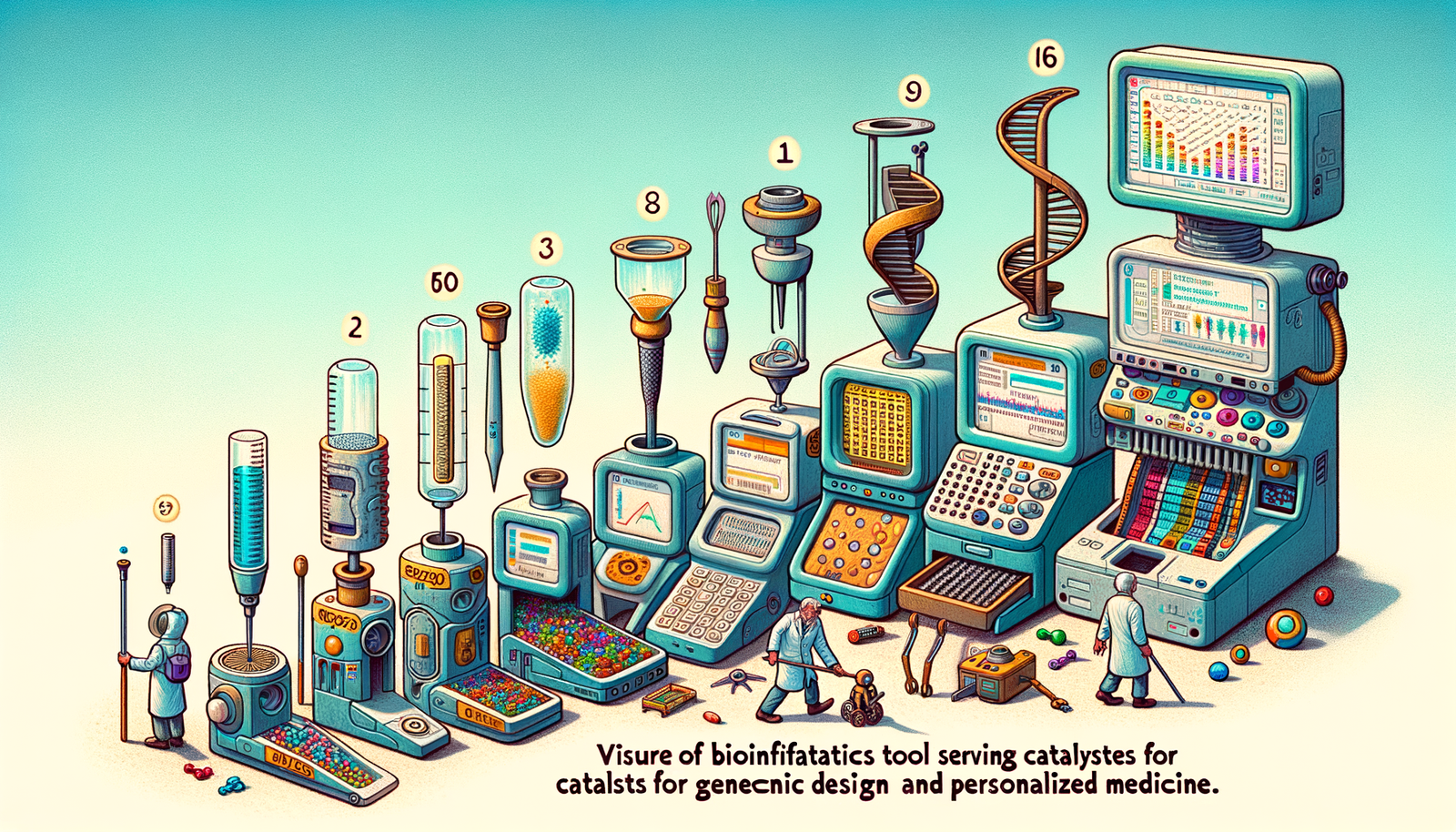Your Cart is Empty
Customer Testimonials
-
"Great customer service. The folks at Novedge were super helpful in navigating a somewhat complicated order including software upgrades and serial numbers in various stages of inactivity. They were friendly and helpful throughout the process.."
Ruben Ruckmark
"Quick & very helpful. We have been using Novedge for years and are very happy with their quick service when we need to make a purchase and excellent support resolving any issues."
Will Woodson
"Scott is the best. He reminds me about subscriptions dates, guides me in the correct direction for updates. He always responds promptly to me. He is literally the reason I continue to work with Novedge and will do so in the future."
Edward Mchugh
"Calvin Lok is “the man”. After my purchase of Sketchup 2021, he called me and provided step-by-step instructions to ease me through difficulties I was having with the setup of my new software."
Mike Borzage
Design Software History: Evolution of Bioinformatics Tools: Catalysts in Genetic Design and Personalized Medicine
October 12, 2024 5 min read


In the rapidly evolving landscape of genetic design, bioinformatics tools have become indispensable. These tools bridge the gap between vast biological data and actionable insights, enabling researchers to decode complex genetic information. The intertwining of bioinformatics and design software has catalyzed advancements in genomics, synthetic biology, and personalized medicine. Understanding the history and evolution of these tools sheds light on how we've harnessed computational power to manipulate and understand genetic material at an unprecedented scale. Over the decades, key players and groundbreaking technologies have emerged, propelling the field forward and opening new horizons in genetic research.
Historical Context
The roots of bioinformatics trace back to a time before digital computation, where genetic analysis was painstakingly manual. Early methods relied on labor-intensive processes such as manual DNA sequencing and protein characterization using rudimentary techniques. The absence of digital tools meant that researchers often spent countless hours interpreting data that today would be processed in mere seconds. The limitations of pre-digital era methods highlighted the need for more efficient ways to manage and interpret biological data.
The advent of the digital age in the 1980s and 1990s marked a significant turning point. During this period, the emergence of software tools revolutionized the field. One of the most notable contributions was the development of the Basic Local Alignment Search Tool (BLAST) algorithm. BLAST, introduced by Stephen Altschul and his colleagues in 1990, provided a method for comparing an input sequence against a database, identifying regions of similarity that could signify functional or evolutionary relationships. This tool became a cornerstone in bioinformatics, widely used for sequence analysis.
Another significant milestone was the creation of the first DNA sequence assembly software. As genome sequencing projects gained momentum, the need for efficient assembly of DNA fragments became apparent. Software like Phred and Phrap, developed by Phil Green and Brent Ewing, revolutionized how researchers assembled and interpreted genomic data. These tools increased accuracy and decreased the time required to assemble sequences, facilitating large-scale projects like the Human Genome Project. Organizations such as the National Center for Biotechnology Information (NCBI) and the European Molecular Biology Laboratory (EMBL) played pivotal roles in data sharing and tool development, fostering a collaborative environment that propelled bioinformatics forward.
Technological Advancements
The progression of bioinformatics software tools has been significantly influenced by core technologies that have evolved over time. Fundamental to this evolution are advanced algorithms designed to handle complex biological computations efficiently. Algorithms for sequence alignment, genome assembly, and phylogenetic analysis have become more sophisticated, enabling more accurate and faster interpretations of biological data. Additionally, the development and utilization of extensive databases, such as GenBank and Protein Data Bank, have provided centralized repositories for genetic and protein information, facilitating accessibility and data sharing among researchers globally.
Machine learning and artificial intelligence have also started playing crucial roles in bioinformatics. These technologies enable the analysis of large datasets to identify patterns and make predictions about genetic functions and interactions. Techniques like deep learning are being applied to predict protein structures and understand complex gene regulatory networks. The incorporation of machine learning algorithms has enhanced the ability to interpret vast amounts of data generated by high-throughput sequencing technologies.
Another significant factor in advancing bioinformatics has been the rise of open-source software. The open-source movement has democratized access to genetic design tools, allowing researchers from around the world to contribute to and benefit from shared resources. Platforms like Galaxy and Bioconductor exemplify this approach. Galaxy provides a web-based platform for accessible, reproducible, and transparent computational biomedical research, allowing users to perform complex analyses without the need for programming expertise. Bioconductor, on the other hand, offers tools for the analysis and comprehension of high-throughput genomic data. These platforms not only provide a suite of tools but also foster a community-driven environment where collaboration and knowledge sharing are encouraged.
- The use of open-source tools accelerates innovation by enabling researchers to build upon existing work.
- Community contributions lead to continuous improvement and validation of bioinformatics software.
Applications and Impact on Genetic Design
Bioinformatics tools have become essential in the field of genetic research and synthetic biology, offering unprecedented capabilities to understand and manipulate genetic material. Researchers utilize these tools to analyze genomic sequences, identify genes, and understand genetic variations that may lead to diseases. In synthetic biology, bioinformatics facilitates the design of new biological parts, devices, and systems by providing computational models that predict the behavior of synthetic genetic constructs.
The impact of bioinformatics on genetic design is profound. For instance, the development of CRISPR-Cas9 gene-editing technology was significantly aided by bioinformatics tools that helped identify and optimize guide RNA sequences for precise gene editing. Additionally, genome-wide association studies (GWAS) rely heavily on bioinformatics to identify genetic variations associated with specific traits or diseases. These studies have led to breakthroughs in understanding complex diseases like cancer, diabetes, and neurological disorders.
However, as the capabilities of bioinformatics expand, ethical considerations become increasingly critical. Issues such as data privacy, especially with personal genetic information, need careful handling to prevent misuse. There's also the concern of genetic discrimination based on genomic data. The potential for creating genetically modified organisms raises ecological and ethical questions about unintended consequences. Therefore, ongoing discussions and regulations are essential to address these concerns while fostering innovation.
- Bioinformatics enables personalized medicine by tailoring treatments based on individual genetic profiles.
- Genetic modifications in agriculture through bioinformatics can lead to enhanced crop yields and nutritional value.
The future implications for bioinformatics research are vast. As technology advances, we can expect even more sophisticated tools that can handle larger datasets and more complex analyses. This progress holds the promise of solving some of the most challenging problems in biology and medicine, from curing genetic diseases to creating sustainable bioengineered products.
Conclusion
Bioinformatics tools have become integral to the advancement of genetic design, serving as the backbone for modern biological research and synthetic biology applications. They have transformed how scientists analyze genetic data, enabling breakthroughs that were once thought impossible. The ongoing evolution of software technologies continues to open new frontiers in genomics, personalized medicine, and beyond, offering tools that are more powerful and accessible than ever before.
Looking ahead, the potential for bioinformatics to revolutionize various fields is immense. The integration of big data analytics, machine learning, and cloud computing promises to further enhance our ability to interpret complex biological data. This progress will likely lead to novel treatments for diseases, improved agricultural practices, and a better understanding of life's fundamental processes.
The importance of interdisciplinary collaboration cannot be overstated in driving future innovations in bioinformatics and genetic design software. It requires the combined efforts of biologists, computer scientists, mathematicians, and engineers to continue pushing the boundaries of what is possible. By working together, these diverse fields can address the challenges and ethical considerations that come with such powerful technologies, ensuring that advancements benefit society as a whole.
Also in Design News

ZBrush Tip: Optimizing Workflow Efficiency Through Custom Hotkeys in ZBrush
January 02, 2025 2 min read
Read More
Revit Tip: Enhancing Project Consistency and Efficiency with Custom Revit View Templates
January 02, 2025 2 min read
Read More
AutoCAD Tip: Enhance Precision with AutoCAD Align Command Techniques
January 02, 2025 2 min read
Read MoreSubscribe
Sign up to get the latest on sales, new releases and more …


